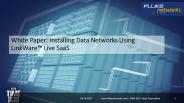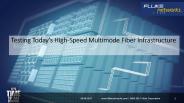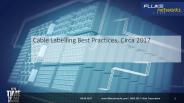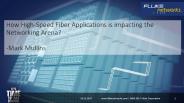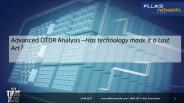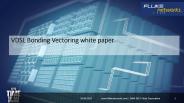Fluke Networks Versiv PowerPoint PPT Presentations
All Time
Recommended
Copper and Fiber cabling industry news, standard changes/updates, customer insights and shared learnings.
| PowerPoint PPT presentation | free to download
Software as a Service (SaaS) continues to grow in popularity across a wide variety of disciplines. Contractors, too, are adopting the approach for everything from bidding to systems design. LinkWare Live from Fluke Networks offers a similar approachto the task of cable certification and systems approval. So what does that look like in practice to a typical installer?
| PowerPoint PPT presentation | free to download
SOCIAL. NETWORKS. Amit Sharma. INF -38FQ. School of Information. University of Texas at Austin ... Social Networks. References. Everybody talks about Networks? ...
| PowerPoint PPT presentation | free to view
In last week’s blog, we took a Closer Look at 40 Gig Duplex Multimode Applications, just one of the many ways that today’s data centers are cost-effectively achieving increased bandwidth in switch-to-switch fiber links. And when we say many ways, we literally mean many. If you take a look at network application standards for balanced twisted-pair cable, there’s not that many to be concerned with. Sure, we had a methodical shift from 10BASE-T, to 100BASE-T, to 1000BASE-T, to 10GBASE-T that then jumped back to 2.5GBASE-T and 5GBASE-T to accommodate new technologies over the installed base and then forward again to the upcoming 25GBASE-T and 40GBASE-T standards, but all of this is nothing compared to fiber. And unlike fiber, there are few, if any, non-standard ways of deploying copper cabling.
| PowerPoint PPT presentation | free to download
TU/e Computer Science, System Architecture and Networking ... 2IC15 Computer Networks. Thanks to. B. A. Forouzan. A. Tanenbaum. 7/11/09. 2 ...
| PowerPoint PPT presentation | free to view
Deliberate Networking ... Networking for your students by Ken Kennedy, Rice ... Networking at NSF by Caroline Wardle, NSF. Populating a start-up by Dave Ditzel, ...
| PowerPoint PPT presentation | free to download
The way in which computers attached to a network share the cable must be defined ... Requires two of the four pairs bundled in a Category 5 twisted-pair cable ...
| PowerPoint PPT presentation | free to view
Multiple networks drive Total Cost of Ownership (TCO) up ... Multiple networks and multiple stacks in the OS are used to provide. these services ...
| PowerPoint PPT presentation | free to view
The Fiber Best Practice Series was designed by Fluke Networks to educate about important optical fiber best practices, including: • Fiber inspection and cleaning • Loss-length (Tier 1) fiber certification • Fiber plant characterization and troubleshooting (Tier 2 certification).This white paper details the best practice of loss-length (tier 1) fiber certification.
| PowerPoint PPT presentation | free to download
The Fiber Best Practice Series was designed by Fluke Networks to educate about important optical fiber best practices, including: • Fiber inspection and cleaning • Loss-length (Tier 1) fiber certification • Fiber plant characterization and troubleshooting (Tier 2 certification) This white paper details the best practice of fiber plant characterization and troubleshooting (Tier 2 certification).
| PowerPoint PPT presentation | free to download
Provide more efficient, scalable, high-speed, secure and manageable networking ... Enable highly scalable networking through hardware offloading and host-based, ...
| PowerPoint PPT presentation | free to view
The Home Networking Wizard provides a user friendly method to configure a TCP/IP ... A setup disk for the Home Networking Wizard can be made that provides the same ...
| PowerPoint PPT presentation | free to view
All over the news and social media, 2016 has gotten a pretty bum rap. With everything from shootings, terrorist attacks and the weirdest presidential election in history, to exploding cell phones, scary clown threats and numerous celebrity deaths, 2016 has been denoted as the worst year ever. But for technology, 2016 wasn’t ALL bad. In a single 2016 Internet minute, 150 million emails were sent, 2.78 million videos were watched on YouTube and Google saw an average of 2.4 million search queries. In fact, compared to 2015, this past year saw a 100% increase for Uber rides, 70% increase in Amazon sales and 186% increase in hours of music on Spotify. That is what we call Big Data, and for our industry, that spells opportunity in 2017 and beyond. And 2016 wasn’t all bad for Fluke Networks either. From new features and capabilities, to industry accolades and even the success of this blog, there are plenty of 2016 events that we are thankful for. Let’s take a look.
| PowerPoint PPT presentation | free to download
... 'bonding' social capital inherent in family and village networks varies according ... Access to village/migration social networks' resources is always imperfect. ...
| PowerPoint PPT presentation | free to view
Private networks in premises and campus environments are moving towards high-speed applications such as Gigabit Ethernet in order to handle the ever-increasing bandwidth requirements for faster data transmission. To achieve faster data transmission rates, 1 or 10 Gigabit Ethernet network devices like routers and switches must use high-speed laser light sources rather than the slower light emitting diode (LED) sources. With both lasers and LEDs used for data transmission, what type of source should you use when certifying optical fiber links?
| PowerPoint PPT presentation | free to download
Social Networks rely on trust because without trust, one ... Node=A people in the social network. N=Number of nodes. Edges ... in Social Networks ...
| PowerPoint PPT presentation | free to view
Unlike required Tier 1 testing for attenuation (insertion loss), length and polarity that can be achieved with an optical loss test set (OLTs), few technicians in the field find themselves faced with Tier 2 testing and the need for an Optical Time Domain Reflectometer (OTDR). But every now and then, there is that one customer or consultant who specifies Tier 2 testing—especially as fiber networks have ever-tighter loss budgets and less room for error. Or there may be the need to gain more insight into the performance of a link component for troubleshooting purposes.
| PowerPoint PPT presentation | free to download
Client Networking IP Settings. Gateway Default Route ... All NMS 'networks' are part of defined VLANs. NMS currently lacks the ability to lookup VLANs and ...
| PowerPoint PPT presentation | free to view
The importance of networks can also be seen in much social capital research. ... Some Antecedents of Social Network Analysis (Freeman) ...
| PowerPoint PPT presentation | free to download
E-mail Scoring mechanism based on a social network augmented with reputation ratings ... Social Networks. Proposed by Boykin and Roychowdhury. Social network ...
| PowerPoint PPT presentation | free to view
1990's social network studies based on electronic communication ... Model social network dynamics by gathering ... Changes in social networks over time: ...
| PowerPoint PPT presentation | free to view
Multimode launch conditions have a significant effect on the loss measurement uncertainty • Encircled Flux (EF) is the final piece in the puzzle to reducing measurement uncertainty in the field • It is a “new” definition of modal launch conditions of a light source • This definition is more stringent than previous definitions such as MPD or CPR
| PowerPoint PPT presentation | free to download
While probably one the least talked about standards, and one that is often considered voluntary, the TIA-606-B labeling standard exists for a reason. An unlabeled infrastructure results in an unmanageable mess that ultimately makes every reconfiguration and troubleshooting task a time-consuming, frustrating and costly tracing game of hunt and peck. Despite the fact that it is an industry best practice, labeling takes time--especially if you're manually creating identifiers for every outlet, every cable, and every patch panel port and managing them in a separate database. So however the essential task of labeling can be accomplished faster, more efficiently and with improved accuracy, the end result is savings.
| PowerPoint PPT presentation | free to download
For professional contractors and installers of data communications cabling systems, compliance with ANSI/TIA 606-B Standards updated back in 2012 has required new levels of precision in cable labeling – often an arduous and time-consuming process for cable installers. Today, however, thanks to smart, cutting-edge cable labeling tools and technologies, that situation has improved dramatically!
| PowerPoint PPT presentation | free to download
A key aspect of the growing number of devices connected to the LAN is the ability to power those devices with evolving PoE technology. With IEEE 802.3bt PoE standards expected to be ratified next year, we will soon be looking at Type 3 PoW at 60W and Type 4 PoE at 90W delivered over all four pairs. While Cisco's UPOE already delivers 60W, next year's ratified PoE standards will open up the door for more PoE-enabled devices than ever before. That combined with power over HDBASE-T (covered in this earlier blog) that delivers up to 100W of DC power in conjunction with video signals paves the way for PoE LED lighting, LED TVs, digital signage and more.
| PowerPoint PPT presentation | free to download
10 /40 /100Gb/s transmission links are typically shared by a vast number of application and users.Claiming that they are most of the time mission critical and that failures are costly will find agreement within the industry. They require caution from the stage of planning, selection of material, installation all the way to the operational phase.
| PowerPoint PPT presentation | free to download
Electricity is present virtually everywhere in the outside plant. There are two key ingredients to keep technicians safe from electrical hazards in the outside plant: training to fully understand the hazards, and awareness to avoid them. We should add a third ingredient because without it, the first two would be mostly useless. That third ingredient would be the right tools to detect and avoid those hazards. This article will give some tips for selecting and using the right tool.
| PowerPoint PPT presentation | free to download
Used primarily by commercial contactors and network technicians, certification testing determines if a link is compliant with a specific category or Class of cable as determined by well-defined parameters outlined in ANSI/TIA-568-C.2 or ISO/IEC standard 11801 (ed. 2). For instance, certification testing will determine if your link is compliant with Category 6 or Class EA standards.
| PowerPoint PPT presentation | free to download
In our last Cable Testing 101 series, we covered the difference between OM3 and OM4 50µm multimode fiber -- primarily the fact that the fiber core of OM4 has been constructed to provide better attenuation and higher bandwidth, thereby allowing for longer link lengths. With OM4 at a premium over OM3, many data centers and LANs not requiring the extra distance afforded by OM4 continue to deploy OM3 multimode fiber cabling, and it remains more widely deployed for that reason. And while the two fiber types can be mixed due to the same core size, there are some considerations in general when it comes to mixing multimode fiber types.
| PowerPoint PPT presentation | free to download
Let’s face it. Spring cleaning stinks. I mean, does anyone actually enjoy cleaning? I don’t know about you, but I certainly am not counting down my winter days until I can scrub the house top to bottom only to have it quickly soiled by muddy feet and paws, beach sand, cut grass and whatever else wanders in with the warmer weather. But dirt happens. And while cleaning may not be a barrel of fun, there is always some sense of satisfaction when it’s done and everything is looking its best.
| PowerPoint PPT presentation | free to download
To maximize return on investment, your test equipment moves from jobsite to jobsite. At any given moment, several of your skilled technicians can be testing and certifying network cabling with multiple testers for multiple concurrent projects in multiple areas—a real recipe for mixing up and misplacing test equipment. The more testers, the more complex it gets to keep track of them. Misplaced test equipment leads to project delays—something 68% of users say they have experienced. Despite the facts, the majority of installers do not actively manage their test equipment assets or use ad-hoc non-standard systems best, such as manual sign out sheets or Excel spread sheets. And yes, there are some installers that still use a peg board to keep track of who has a tester.
| PowerPoint PPT presentation | free to download
If you’ve ever seen a technician using canned air or dusters for cleaning fiber end-faces, you’ve witnessed a very ineffective practice. Not only do canned air and dusters just succeed in blowing particles around, they are not all adequate for cleaning oils, residues, or small charged dust particles. Instead, use fabric and composite wipes made of lint-free material that provide the absorbency to remove contaminants from the end-face. But please remember to discard wipes after it’s been used up—a dirty wipe is the next dirty end face. Yet beware of using wipes alone—often referred to as “dry cleaning”—as this can leave a static charge on the fiber end face that actually attracts statically charged dust particles. A combination of composite wipes and solvent is really the way to go—solvents boost the cleaning ability of the wipe while eliminating the issue of static charge.
| PowerPoint PPT presentation | free to download
Since the development of 40GBASE-T (IEEE 802.3bq) began a few years ago, most of us believed that the next Ethernet data center speed for twisted-pair copper cabling beyond 10 Gb/s would be 40 Gb/s.
| PowerPoint PPT presentation | free to download
When TIA adopts an IEC standard, or vice versa, it quite literally means that they take on and follow the standard. For example, TIA adopted the IEC 61280-4-1 multimode fiber optic testing standards as TIA-526-14-C. Because TIA has an outdated singlemode fiber optic testing standard, they are also considering the adoption of IEC 61280-4-2. If they do, it will be published as TIA-526-7.
| PowerPoint PPT presentation | free to download
The standards review board of the Institute of Electrical and Electronics Engineers (IEEE) approved the standard for 10 Gigabit/sec Ethernet over twistedpair copper cabling (10GBASE-T) on June 8, 2006. This paper provides an overview of the methods to measure and certify the performance of the installed cabling system for compliance with the requirements of 10GBASE-T, as well as with the draft specifications of Augmented Cat 6 (Cat 6A) or Augmented Class E(Class EA).
| PowerPoint PPT presentation | free to download
When we make an OTDR (Optical Time Domain Reflectometry) measurement, we use the launch cable to allow the trace to settle down after the pulse(s) are sent into the fiber, allowing us to see and analyse the start of the fiber being tested. This is because a large event will be seen in front of the connection on the trace usually caused by reflectance from the connector on the OTDR, thus not allowing us to make a good measurement of the first connection. The launch fiber also overcomes the issue of any dead zone (unseen event) that may occur if the pulse width is wider than the distance to a connector a short distance away from the OTDR connector.
| PowerPoint PPT presentation | free to download
How much time and money would you save if you could assure the performance of your data center’s 10 Gigabit Ethernet network, before you turned up service? How much confidence would you gain by knowing the 10 Gigabit cabling was installed according to standards? This paper describes changes 10 Gigabit Ethernet brings to the network infrastructure and the specific steps you can take to make your new data center network rock-solid.
| PowerPoint PPT presentation | free to download
This primary international standard provides guidance for measurement of attenuation using power meters, light sources and OTDRs on 50/125 µm and 62.5 µm multimode fiber cabling that may include connectors, adapters and splices. Various test methods and cabling configurations are described. This report gives important information regarding upcoming changes for anyone needing to specify testing. Architects, Consultants and Engineers may use this information to learn of changes in IEC, anticipate customer concerns and gain insight to cabling testing trends.
| PowerPoint PPT presentation | free to download
Is the ability to manually set up tests and interpret Optical Time Domain Reflectometer (OTDR) traces becoming a lost art, due to embedded processors and sophisticated software? This article discusses some of the advanced OTDR techniques that expert technicians use to perform during testing. Similar to a digital photographer’s film camera experience, an understanding of the knowledge and skills used for manual OTDR testing can enhance a technician’s fiber testing when using the latest OTDR with automatic capabilities
| PowerPoint PPT presentation | free to download
As fiber grows more common, network owners, network technicians and network installers are paying more attention to the two crucial devices for certifying fiber optical cable: the Optical Loss Test Set (OLTS) and the Optical Time Domain Reflectometer (OTDR). While the measurements taken by these instruments seem similar, they perform distinct yet important roles in the fiber certification process. This paper explains how each product works and how they complement each other to prevent network problems.
| PowerPoint PPT presentation | free to download
You’ve just finished a copper cabling installation for a customer, your DSX-5000 CableAnalyzer is properly configured and you’re ready to start testing. With a press of the “TEST” button, you’re off and running. Link after link, the tester displays a “Pass” and you’re feeling really good about the quality workmanship of your installation. All of the sudden, a “Fail” pops up on the screen and you’re forced to stop dead in your tracks. You know that all links must pass before the manufacturer will issue the warranty—and likely before you get paid for the job. Quickly isolating and repairing the problem can make all the difference in getting on with the business of warranting the installation, ensuring customer satisfaction and making money. Thankfully you have the powerful troubleshooting capabilities of the DSX-5000 in the palm of your hand.
| PowerPoint PPT presentation | free to download
In our last 101 Series Blog, we took at closer look at everything in blue at the top of your LinkWare Report. But what if your customer wants you to explain the detail and those pretty charts to the right? Let's dive deeper so you're prepared for that possibility.
| PowerPoint PPT presentation | free to download
You have likely heard copper network cabling referred to as balanced twisted-pair copper cabling, and maybe you’ve heard of the testing parameter referred to as DC resistance unbalance. But what does all this balance-related terminology really mean, and why should you care?
| PowerPoint PPT presentation | free to download
Over the last few years, Category 8 has been gathering momentum, and TIA is now moving the 568-C.2-1 draft for this cabling to an industry ballot. This means it is possible that we could see publication as early as the end of this year. While category 6A and 10GBASE-T are just now becoming commonplace in the data center for switch-to-server connections, we can now say that copper cabling technology will be ready for what comes next—25GBASE-T and 40GBASE-T. As they did with category 6A, early adopters will therefore jump on the category 8 bandwagon.
| PowerPoint PPT presentation | free to download
This paper describes test methods for the various cabling configurations. Polarity is not discussed in this paper and it is assumed the test equipment automatically detects and reports the polarity properly. In the examples shown below, unpinned test equipment is used except for the channel test method. Five various procedures are shown.
| PowerPoint PPT presentation | free to download
Today’s office environments are changing drastically in regards to where and how people work. Gone are the days of segregated work areas for each employee with siloed spaces featuring strictly wired connections for a computer and a phone. Companies today are striving for more open, harmonious work environments and taking advantage of new trends such as collaborative work spaces, BYOD and a combination of work-from-home policies and office hoteling—the practice of reserving work space when needed rather than assigning permanent spaces to employees.
| PowerPoint PPT presentation | free to download
With the growth of the Internet of Things (IoT) and intelligent buildings, there are more devices than ever being connected to the network, and many of them reside in the ceiling space--everything from LED lights and building automation devices, to Wi-Fi access points and security devices. And because zone cabling offers significant benefits for these highly automated buildings, this cabling topology is on the rise and it may be time to test out of your comfort zone.
| PowerPoint PPT presentation | free to download
Network MotifsStatisticalgraph theoretic analyses of complex biological systems
| PowerPoint PPT presentation | free to download
Alien crosstalk is a relatively new measurement that’s widely misunderstood. I’m often asked why it’s an important measurement and if it’s required to be measured by the standards. Also misunderstood is the sampling criteria for alien crosstalk measurements, which are applied so that not all links have to be tested?
| PowerPoint PPT presentation | free to download
While upgrading backbone cable plants in the LAN to support 10 Gig has been going on for several years since the release of the 10GBASE-SR standard for fiber, many enterprise businesses did not previously require these types of speeds, until now. Data centers are rapidly migrating to 25, 40 and even 100 Gigabit speeds to accommodate an increasing amount of virtualized servers that host more applications than ever before and vast volumes of data that needs to be accessed, transmitted and stored. At the same time, the demand for high speed transmission in the LAN is at an all-time high for both wired and wireless connections. While many larger enterprise businesses like universities and financial institutions have already upgraded their LAN backbones, there are still a vast number of others that are just now coming to the realization that 1 gigabit speeds are no longer adequate
| PowerPoint PPT presentation | free to download
Social Network Methods and Measures for Examining E-Learning. WUN/ESRC Seminar Series ... Learning is a Social Network Relation. An interaction, transaction, ...
| PowerPoint PPT presentation | free to view
The Texas High Plains ET TXHPET Network development, operation and use
| PowerPoint PPT presentation | free to view
Russia-China-USA Science & Education Network. April 14, 2003 ... Russia-China-USA Science & Education Network. Organizing Trip. with Chinese Academy of Sciences ...
| PowerPoint PPT presentation | free to view
Multimedia Wireless Transmission with Network Coding. Dong Nguyen (Oregon State University, USA) ... Network coding: combine packets before sending ...
| PowerPoint PPT presentation | free to view
The next generation of VDSL2 technology call Bonding & Vectoring promises performances upwards of 100Mbs on your existing copper network (FTTN). This allows you to economically deliver significant performance boost to your customers without costly fiber investment. But can your copper plant handle the demands of bonding & vectoring ?
| PowerPoint PPT presentation | free to download
By now you will have heard about the new OptiFiber Pro OTDR and that’s a relief for me because I’ve been biting my tongue for a while! Now that its been announced, let me share my impressions and an overview of what makes the product unique. I will also include some links to more detailed information. Take this from a guy that has spent five of the last seven years playing with OTDRs… I’ve used them all. And this one is going to change everything!


